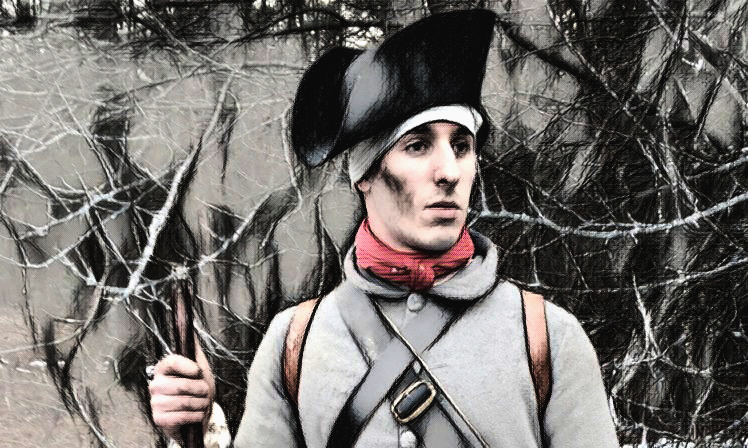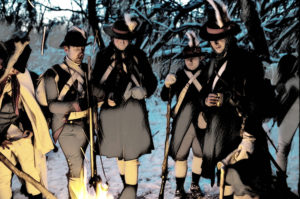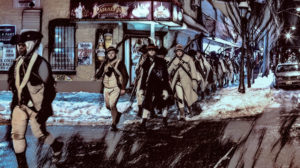Around midnight, the familiar sound of a wooden door screeching open on its iron hinges woke me. The tattered and scratchy woolen blanket, the roaring snores of 40 other men, and the bone-chilling cold made for a short and uncomfortable sleep in Trenton, New Jersey. I rose from the stiff, wooden boards. From the darkness of the doorway, a guttural yell shouted the words I dreaded: “Form up!” I reached for my linen knapsack, which served as a makeshift pillow, and stuffed my blanket inside. Then I grabbed my 12-pound musket off of the wall beside me. Everyone around me moved slow, soundless.

In that dark silence, we prepared ourselves for an event we agreed to months ago. As I headed for the door, I began to doubt my decision. I wondered why I signed up to be physically and mentally miserable instead of hanging out with my friends in a warm dorm room at Villanova University, or sleeping in my own bed at home. I lacked a good reason for this choice except that I had re-enacted the Revolutionary War as a hobby since I was in ninth grade. I knew from previous experience that some re-enactments just call you into attendance. I didn’t know it on that night, but I was about to witness and experience an event that would be marked by some of the best and worst feelings this hobby could provide. The date was January 3, 2015, but I don’t remember it that way. To me, it was January 3, 1777, and it was the day that I experienced a “period moment” like no other in my time as a re-enactor.
As I wrestled with my motivation for being there, my compatriots and I staggered out of the 256-year-old barracks building in downtown Trenton. Fueled by sheer habit, every man fell into formation beside one another, turning back around to face the historic structure. My eyes adjusted to the pitch black that surrounded me. As I looked around, I felt a surge of purpose. I turned my head to the right and realized I was located at the end of a line composed of talented historians and re-enactors. Most of us tediously had made the clothing and equipment that we wore on that frigid night. I knew at least half of us had stayed up the entire night before the event sewing in our basements. We wanted to ensure we looked the part out of respect for the soldiers we represented. My breath froze in the air in front of me. The light of the campfires glinted off our pewter buttons and the iron muskets that leaned against our shoulders glinted in the light of the campfire. As I looked up, I scanned the imposing stone structure that American soldiers would have seen nearly 240 years before me and gazed up at the night sky peppered with stars. Then my friend Matt, dressed as an officer in a brown coat faced in scarlet with silver buttons, stepped up to address us. In his hands, he held a pamphlet titled American Crisis. It was written by the famous orator Thomas Paine during the winter of 1776 when the Continental Army was on the verge of defeat and dissolution. The words inside it set my heart on fire.

Matt’s booming voice echoed across the parade ground as he recited the words originally read to soldiers from Philadelphia. “The summer soldier and sunshine patriot will, in this crisis, shrink from the service of his country,” Matt read as the embers from the camp fires floated above us. The soldiers we portrayed were far from sunshine patriots. I felt, just as they must have, that we were surrounded by thousands of experienced British soldiers poised to strike us down. Matt continued on and read, “Let it be told to the future world that in the depth of winter, when nothing but hope and virtue could survive, that the city and the country, alarmed at one common danger, came forth to meet and repulse it!”
This served as a critical moment to defend the values enshrined in the Declaration of Independence. We represented the posterity of “the city and the country” that Thomas Paine referred to. The soldiers who marched before us were poor laborers and immigrants, and they made up the majority of an army on the verge of defeat. Each and every one of those individuals fought for their own access to the inalienable rights of life, liberty, and the pursuit of happiness. To me, those stood out as rights worth defending, and that could only be done by taking the fight to the enemy. We would follow in the footsteps of those that came before us, tracing the route that Gen. George Washington’s army marched from Trenton to Princeton. The hope was to surprise and defeat an isolated group of enemy soldiers stationed there to achieve a much needed victory. There was only one problem. Princeton stood 15 miles away, and we were yet again “in the depths of winter.” My friends and I each carried 60 to 80 pounds of gear, wore accurately reproduced wool clothing, and walked with leather buckled shoes on our feet. We had to march the entire way to Princeton and make it before the rising sun exposed our position. “Time hath found us,” as Paine wrote in his 1776 pamphlet Common Sense.
Every step on that march to Princeton became my own personal battle. My joints began to chafe against the clothes intended to protect me from the freezing night air. I took my blanket out of my knapsack and wrapped it around my body as I inched forward. But the added layer made me sweat. When I took the blanket off, the sweat froze against my body. Chills followed. It seemed that no position I took offered comfort against the New Jersey winter. But we all kept marching, and none of us dared to stop. If you didn’t keep your blood moving, you would shiver. I remember stopping for five minutes to rest about halfway through the march. I had never experienced cold like this. Just for some ounce of warmth, my friends and I dog piled on top of one another to avoid being isolated from the huddle. I dreamed of a hot shower. The water in my canteen had turned to ice by the time we marched again. I no longer felt my feet, which were covered with several layers of wool stockings, inside my leather shoes. We inched closer over paved roads and forested trails. Hours passed and a light began to break on the horizon. In those twilight hours, a single northern star remained to guide us. As night gave way to the advancing daylight, we stopped to rest. I pulled off my shoes and stockings and discovered my feet were covered in blisters. I had lost several toe nails. I could not feel pain anymore. Warmth became my primary concern. Someone handed me a tin cup as soldiers began to share the same rum ration given to those brave Philadelphians on the eve of battle. I downed the alcohol. It burned but released a radiating warmth that traveled from my throat outward. It reenergized me, if only for a moment.
As we emerged from a nearby wood line, I saw thousands of visitors lining the hill overlooking the Princeton battlefield. The crowd gasped in delighted surprise as we barreled toward the thin red line composed of other re-enactors who represented red-coated British troops. They would have been equally as shocked to see us on January 3, 1777, believing the American army had remained in Trenton. With our arrival at Princeton we successfully launched a surprise attack on the isolated rear of the British forces, just as Washington’s men had done before us. Without the long march from Trenton around the main part of the British army, this feat would not have been possible. We represented troops that were sent in to turn the tide of battle. The American lines initially faltered when British soldiers dehorsed American Gen. Hugh Mercer and bayoneted him to death. Then they overwhelmed his men, and it seemed that the battle would be lost. But Washington and other officers rushed forward, accompanied by the Philadelphians we now represented. With the exchange of several crisp volleys from the mouths of our muskets, the air filled with smoke. My compatriots and I stopped the red coats and crippled their advance. The command, “Charge your bayonets!” rang through the air. After firing one last volley, we leveled our muskets, affixed with sharp steel, toward the enemy. In the smoke and confusion, the enemy troops retreated up the hill as we pursued them to ensure total dominance of the field. With victory secured, we dispersed to interact with the public who came to witness our efforts early that morning.

When I got home and sunk my body into the steaming water of a bath, the warmth and the comfort allowed me to reflect. Physically, it was the worst I had ever felt after a re-enactment. My limbs were nearly immobile, and my feet were torn to shreds. But mentally and emotionally, the two days delivered an understanding and an awakening I continue to carry today. I now possessed an inkling of what the revolutionary generation must have felt at one of the most critical points in our nation’s birth story. I also grasped the gravity of that situation in a way not captured on a written page or in a movie’s flicker of images. As a reenactor, I walked in the footsteps of ordinary people who sacrificed much to achieve extraordinary ends. Although it is easy to idolize Washington, Hamilton, and Adams, it is also important to remember these other, ordinary legends of American history. Though the nation they fought to create was, and still is, fundamentally flawed, I continue to look to the example they set. In fact, I carry the cold, painful lesson of that two-day event with me every day.
Just like the individuals who fought at the Battle of Princeton, poor laborers and immigrants sustained the Revolution. Those same individuals went on to build this country and attempted to improve it for posterity’s sake. If they were willing to make those sacrifices for my generation, then I determined it to be paramount to stand in solidarity with immigrant communities and economically disaffected communities. Most recently, I have become more active with organizations in my hometown of Philadelphia that engage in activism against policies that oppress the majority of the city’s residents. On May 1, our organization planned and carried out a rally on Drexel University’s campus in response to the school president’s willingness to work with ICE agents in the detainment and deportation of “undocumented” immigrants. I played a significant part in the planning process by taking an organizational role in meetings and spreading the word via canvassing. We were outspoken in our opposition to an ideology that would deprive Philadelphia of some of its most hard-working and talented residents.
This rally culminated in a march to City Hall where we joined others working toward changing the current political climate. The rally attracted support for our cause, but it was only the first step. It must be part of an ongoing process to ensure that the privileges enshrined in the declaration of independence can be enjoyed equally by all who live in this country, not just some. It won’t be an easy road forward. I understand that change does not come just because we wish it to. It comes only when we endeavor to weather the most intense storms before us. It is crucial that we heed the advice of Thomas Paine by alarming ourselves to common dangers and coming together to repulse them. We must have the courage to face our own American crisis. To me, when considering how we might change the course of history, there is no experience more enlightening and no lesson more valuable than what I experienced and learned on that cold 15-mile march. Those revolutionaries did just that — they changed the course of history — on that field at Princeton. If we harness their perseverance, we can too.
All photos courtesy of Dan Center. Cover illustration by Ankur Dang.
1 comment